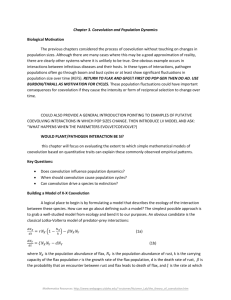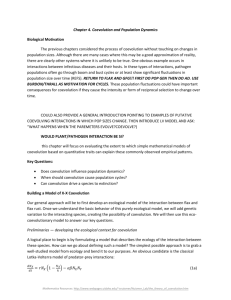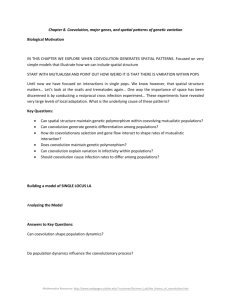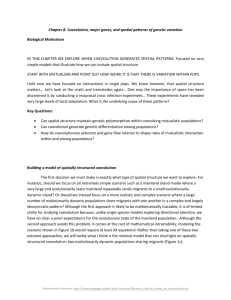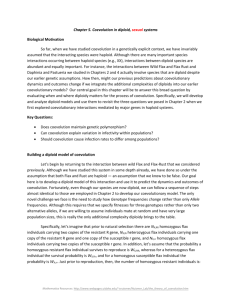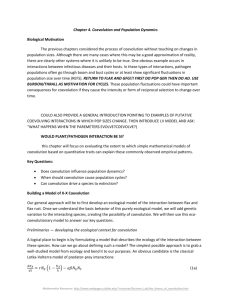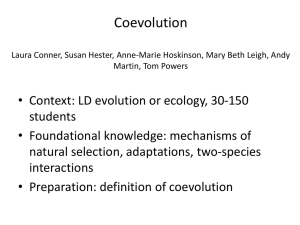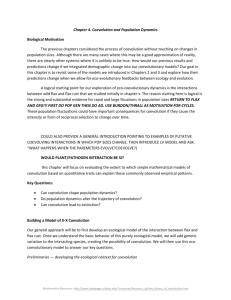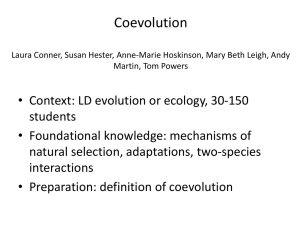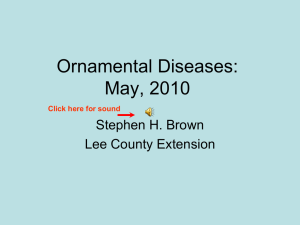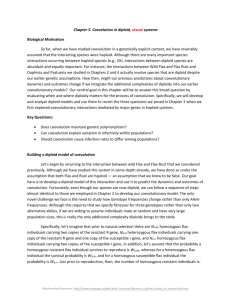Chapter 4. Coevolution and Population Dynamics Biological
advertisement
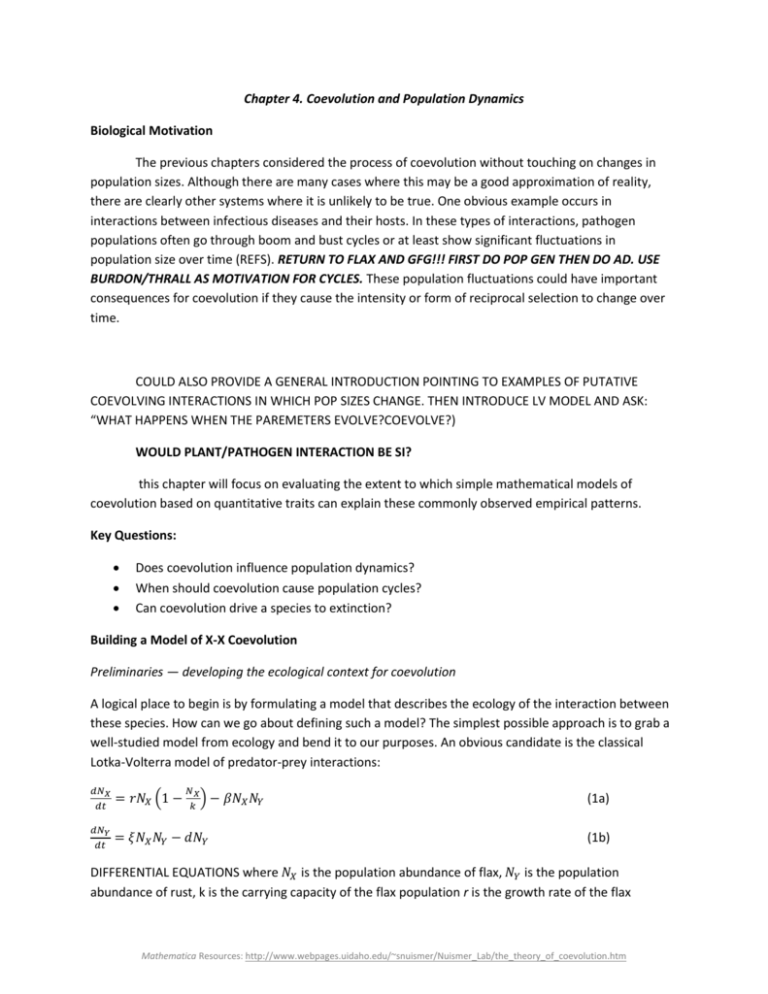
Chapter 4. Coevolution and Population Dynamics Biological Motivation The previous chapters considered the process of coevolution without touching on changes in population sizes. Although there are many cases where this may be a good approximation of reality, there are clearly other systems where it is unlikely to be true. One obvious example occurs in interactions between infectious diseases and their hosts. In these types of interactions, pathogen populations often go through boom and bust cycles or at least show significant fluctuations in population size over time (REFS). RETURN TO FLAX AND GFG!!! FIRST DO POP GEN THEN DO AD. USE BURDON/THRALL AS MOTIVATION FOR CYCLES. These population fluctuations could have important consequences for coevolution if they cause the intensity or form of reciprocal selection to change over time. COULD ALSO PROVIDE A GENERAL INTRODUCTION POINTING TO EXAMPLES OF PUTATIVE COEVOLVING INTERACTIONS IN WHICH POP SIZES CHANGE. THEN INTRODUCE LV MODEL AND ASK: “WHAT HAPPENS WHEN THE PAREMETERS EVOLVE?COEVOLVE?) WOULD PLANT/PATHOGEN INTERACTION BE SI? this chapter will focus on evaluating the extent to which simple mathematical models of coevolution based on quantitative traits can explain these commonly observed empirical patterns. Key Questions: Does coevolution influence population dynamics? When should coevolution cause population cycles? Can coevolution drive a species to extinction? Building a Model of X-X Coevolution Preliminaries — developing the ecological context for coevolution A logical place to begin is by formulating a model that describes the ecology of the interaction between these species. How can we go about defining such a model? The simplest possible approach is to grab a well-studied model from ecology and bend it to our purposes. An obvious candidate is the classical Lotka-Volterra model of predator-prey interactions: 𝑑𝑁𝑋 𝑑𝑡 = 𝑟𝑁𝑋 (1 − 𝑁𝑋 )− 𝑘 𝑑𝑁𝑌 𝑑𝑡 = 𝜉𝑁𝑋 𝑁𝑌 − 𝑑𝑁𝑌 𝛽𝑁𝑋 𝑁𝑌 (1a) (1b) DIFFERENTIAL EQUATIONS where 𝑁𝑋 is the population abundance of flax, 𝑁𝑌 is the population abundance of rust, k is the carrying capacity of the flax population r is the growth rate of the flax Mathematica Resources: http://www.webpages.uidaho.edu/~snuismer/Nuismer_Lab/the_theory_of_coevolution.htm population, d is the death rate of rust, 𝛽 is the probability that an encounter between rust and flax leads to death of flax, and 𝜉 is the rate at which encounters between flax and rust cause infection and production of new rust individuals (REFS). No doubt, you are now wondering why we would use a classical model of a predator prey interaction for the host-pathogen interaction between flax and flaxrust. What can we learn about the ecological dynamics of this interaction from this simple model? Hopefully, we will be able to answer some simple questions such as whether or not cycles are possible, if there are stable equilibria, and when both of the species are likely to coexist. The simplest way to tackle these questions would be to solve the system of differential equations (1) directly. This would give us a complete solution telling us the abundance of flax and rust at any possible point in time as a function of the model parameters. Unfortunately, however, such a general solution is really not practical. Instead, we will have to satisfy our curiosity by identifying equilibria and assessing their stability. Even though we are now working with differential equations rather than the discrete difference equations we explored in earlier chapters, the procedure for identifying equilibria is identical: simply set the left hand side of the equations equal to zero and solve the resulting system of equations: 0 = 𝑟𝑁𝑋 (1 − 𝑁𝑋 )− 𝑘 𝛽𝑁𝑋 𝑁𝑌 (2a) 0 = 𝜉𝑁𝑋 𝑁𝑌 − 𝑑𝑁𝑌 . (2b) Using only relatively simple algebra it is possible to show that there are three possible equilibrium solutions: 𝑁𝑋 = 0 𝑎𝑛𝑑 𝑁𝑌 = 0 (3a) 𝑁𝑋 = 𝑘 𝑎𝑛𝑑 𝑁𝑌 = 0 (3b) 𝑑 𝑁𝑋 = 𝛼𝜉 𝑎𝑛𝑑 𝑁𝑌 = 𝑟(𝛼𝑘𝜉−𝑑) 𝛼 2 𝑘𝜉𝛽 (3c) where the first represents extinction of both species, the second the extinction of the rust only, and the third coexistence of both species. But when, if ever, will each of these equilibria occur? To answer this question, we must analyze the local stability of these equilibria. Just as we did for the system of discrete time equations describing changes in allele frequencies (chapter 2), the first step is to create a Jacobian Matrix. For the system of ordinary differential equations (2), this Jacobian Matrix is given by: 𝑟− 𝐽=[ 2𝑟𝑁𝑋 𝑘 − 𝛼𝛽𝑁𝑌 𝛼𝜉𝑁𝑌 −𝛼𝛽𝑁𝑋 𝛼𝜉𝑁𝑋 − 𝑑 ]. (4) For the three ecological equilibria (3), the eigenvalues of this Jacobian are: 𝜆1 = 𝑟 𝑎𝑛𝑑 𝜆2 = −𝑑 (5a) 𝜆1 = −𝑟 𝑎𝑛𝑑 𝜆2 = 𝛼𝜉𝑘 − 𝑑 (5b) 𝜆1 = −𝑟𝑑+√𝑟√𝑑√𝑟𝑑+4𝛼𝑑𝑘𝜉−4𝛼2 𝜉 2 𝑘 2 2𝛼𝑘𝜉 𝑎𝑛𝑑 𝜆2 = −𝑟𝑑−√𝑟√𝑑√𝑟𝑑+4𝛼𝑑𝑘𝜉−4𝛼2 𝜉 2 𝑘 2 2𝛼𝑘𝜉 (5c) respectively. Thankfully, we are done with the math for a bit and can now sit back and think about what these results tell us about the ecological dynamics of our interaction. Let’s start with the simplest and most transparent results. First, the equilibrium where both species are extinct is never locally stable because one of its eigenvalues is always positive and real. This makes perfect biological sense since we would imagine that the Flax population would always increase from rarity in the absence of any infection by Flax Rust or intraspecific competition. Second, the equilibrium where only Flax is presence can be locally stable, but only if the rate at which the Flax rust dies exceeds the rate at which it can be produced by infections of a Flax population at its carrying capacity k. So far so good, right? Unfortunately, now we need to spend a bit of time understanding when the third equilibrium is stable, allowing us to identify those conditions that allow Flax and Flax rust to potentially coexist. With those simple results in hand, we can move on to trying to figure out when the third equilibrium is likely to evolve. Right off the bat, we can draw one conclusion of biological importance: because in continuous time systems only the real part of the eigenvalue determines stability, this equilibrium must be locally stable (WRONG) Analyzing the Model Answers to Key Questions: When should coevolution cause arms races and escalation? What factors determine which species wins? Should we expect coevolution to cause traits of interacting species to match? New Questions Arising: . At the same time, however, our model analyses raise several important questions: What keeps arms races from escalating in perpetuity? Do our results hold for antagonistic interactions with a different mechanistic basis? How would our results differ for other types of ecological interaction? In the next three sections, we will develop generalizations of our simple model which allow us to answer these questions and gain further insight into the process of coevolution mediated by quantitative traits. Generalizations Generalization 1: What keeps arms races from escalating in perpetuity? Generalization 2: Interactions with a different mechanistic basis Generalization #3: Other forms of ecological interaction Conclusions and Synthesis References Figure Legends Figure 1. The interaction function 𝑃(𝑥, 𝑦) for three different values of the parameter α. Larger values of α cause the probability of successful oviposition by the weevil to fall off more rapidly as the thickness of the camellia pericarp increases. Figure 2. The exact interaction function 𝑃(𝑥, 𝑦) (solid line), and its quadratic approximation (dashed line), for three different values of the parameter α. As the value of α increases, the range of phenotypes over which the quadratic approximation remains accurate decreases. Figure 3. The coevolution of the difference between population mean pericarp thickness in the Camellia and rostrum length in the weevil, 𝛿 = 𝑦̅ − 𝑥̅ , over 100 generations. The solid line shows a case where 𝐾 > 0, indicating the camellia has a greater response to selection. In this case, pericarp thickness increases more rapidly than rostrum length. The dashed line shows a case where 𝐾 < 0, indicating the weevil has a greater response to selection. In this case, rostrum length increases more rapidly than pericarp thickness. In both cases, coevolution generates sustained arms races where mean rostrum length and pericarp thickness increase in perpetuity. Figure 4. Gaussian stabilizing selection for three different values of the parameter γ. In all cases, the optimal phenotype is θ = 0. Figure 5. The exact fitness function 𝑊(𝑧) (solid line), and its quadratic approximation (dashed line), for three different values of the parameter γ. As the value of γ increases, the range of phenotypes over which the quadratic approximation remains accurate decreases. Figure 6. Coevolutionary dynamics of population mean trait values (left hand panels) and corresponding rates of interspecific interaction (right hand panels). In panels a and b, the weevil experiences only very weak selective constraints acting on rostrum length (γX = 0.01), whereas the Camellia pericarp is strongly constrained (γY = 0.06). As a consequence, coevolutionary selection is able to significantly exaggerate rostrum length but not pericarp thickness, thus increasing the average rate of parasitism by the weevil over time. In panels c and d, weevil rostrum length is strongly constrained (γX = 0.06) whereas Camellia pericarp experiences only weak constraints (γY = 0.01). As a consequence, coevolutionary selection is able to significantly exaggerate pericarp thickness but not rostrum length, thus decreasing the average rate of parasitism by the weevil over time. Figure 7. The interaction function 𝑃(𝑥, 𝑦) for three different values of the parameter α. Larger values of α cause the probability of successful nest parasitism to fall off more rapidly with differences in cuckoo and warbler egg coloration. Figure 8. The exact interaction function 𝑃(𝑥, 𝑦) (solid line), and its quadratic approximation (dashed line), for three different values of the parameter α. As the value of α increases, the range of phenotypes over which the quadratic approximation remains accurate decreases. Figure 9. The coevolution of the difference between population mean egg coloration in warbler and cuckoo, 𝛿 = 𝑦̅ − 𝑥̅ , over 200 generations. The solid line shows a case where 𝐾 > 0, indicating the warbler has a greater response to selection. In this case, the mean egg coloration of the warbler population increases more rapidly than that of the cuckoo population. The dashed line shows a case where 𝐾 < 0, indicating the cuckoo has a greater response to selection. In this case, the egg coloration of the cuckoo increases more rapidly than that of the warbler population, resulting in a matching equilibrium where the egg coloration of the two species is identical. Figure 10. The interaction function 𝑃(𝑥, 𝑦) for three different values of the parameter α. Larger values of α cause the probability of successful consumption and dispersal of nutmeg seeds by the toucan to decline more rapidly as seed size increases relative to beak depth. Figure 11. Coevolutionary dynamics of population mean trait values (left hand panels) and corresponding rates of interspecific interaction (right hand panels). In panels a and b, the nutmeg experiences only very weak selective constraints acting on seed size (γX = 0.01), whereas Toucan beak depth is strongly constrained (γY = 0.06). As a consequence, coevolutionary selection is able to significantly reduce seed size but not beak depth. In panels c and d, nutmeg seed size is strongly constrained (γX = 0.06) whereas Toucan bill depth experiences only weak constraints (γY = 0.01). As a consequence, coevolutionary selection is able to significantly exaggerate bill depth but not significantly reduce seed size. In both cases, the rate at which toucans consume and disperse nutmeg seeds by increases over time because coevolutionary selection drives the mean phenotypes of both species in a direction which promotes the interaction.
